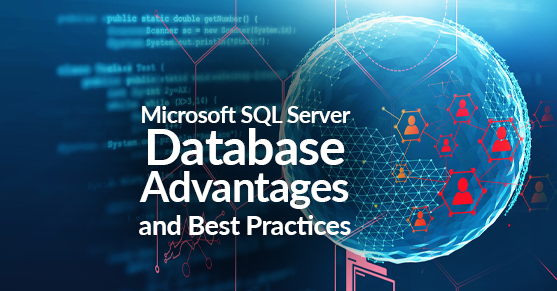As a technical corporate decision-maker, choosing the right database management system (DBMS) for your organization is crucial to ensuring efficient and effective data management. Microsoft SQL Server is one of the most popular DBMS options on the market today and for good reason. In this post, we’ll explore the advantages of Microsoft SQL Server and best practices for its implementation.
Advantages of Microsoft SQL Server
- Scalability: Microsoft SQL Server can scale up or down as needed, making it an excellent choice for organizations of any size.
- Security: SQL Server has built-in security features such as encryption and auditing, helping to protect sensitive data from unauthorized access.
- Integration with Microsoft Products: SQL Server integrates seamlessly with other Microsoft products, such as SharePoint and PowerBI, making it easier to work with data across platforms.
- Business Intelligence: SQL Server includes powerful business intelligence tools, such as SQL Server Reporting Services and SQL Server Analysis Services, which allow users to analyze data and make informed business decisions.
- High Availability: SQL Server has built-in features such as Always On Availability Groups, which provide automatic failover and disaster recovery capabilities, ensuring that data is always available when it’s needed.
- Multilingual: SQL Server supports multiple programming languages such as T-SQL, Python, R, and JSON.
- Support for Large Data Volumes: SQL Server can handle large data volumes, making it ideal for data-intensive applications and large-scale data warehouses.
- Strong Community Support: SQL Server has a large community of developers and users who regularly share best practices, tips, and tricks.
- Flexible Licensing: SQL Server offers flexible licensing options, allowing organizations to choose the best licensing model for their needs.
- Cloud Integration: SQL Server can be easily integrated with cloud platforms such as Microsoft Azure, providing additional flexibility and scalability.
Best Practices for Implementing Microsoft SQL Server
- Design for Scalability: When designing a SQL Server environment, consider future growth and ensure that the system can scale to accommodate increased usage and data volumes.
- Optimize Performance: Regularly monitor and optimize SQL Server performance to ensure that it’s operating at peak efficiency.
- Backup and Recovery: Implement a backup and recovery strategy to ensure that data can be restored in the event of data loss or system failure.
- Security: Implement appropriate security measures to protect data from unauthorized access or breaches.
- Regular Maintenance: Perform regular maintenance tasks such as database backups, index maintenance, and software updates to keep SQL Server running smoothly.
- Standardize Naming Conventions: Consistent naming conventions can help maintain database organization and make it easier to search for and retrieve information.
- Follow Data Retention Policies: Establish clear data retention policies to help manage data growth and ensure regulatory compliance.
- Use Appropriate Data Types: Choosing appropriate data types can help improve performance and minimize storage requirements.
- Monitor System Activity: Regularly monitor system activity to identify potential issues and address them before they become serious problems.
- Document the Environment: Keep comprehensive documentation of the SQL Server environment, including hardware, software, and configurations, to help with troubleshooting and future maintenance.
While SQL Server has many advantages, there are also potential disadvantages that organizations should be aware of before choosing to use it.
Potential Disadvantages of Microsoft SQL Server
- Cost: Microsoft SQL Server can be expensive, especially for larger organizations or those with high data volumes.
- Complexity: SQL Server can be complex to configure and manage, requiring specialized skills and knowledge.
- Resource Intensive: SQL Server can be resource-intensive, requiring significant hardware and software resources to run efficiently.
- Limited Portability: SQL Server is primarily designed for the Windows platform, limiting its portability to other platforms such as AIX and Unix.
- Licensing: Licensing models can be confusing and may require significant management and monitoring to ensure compliance.
- Performance Limitations: While SQL Server is generally known for its high performance, it may not perform as well as other database management systems in certain use cases.
- Data Fragmentation: Without proper maintenance, data can become fragmented over time, potentially impacting system performance.
- Customization: Customizing SQL Server to meet specific business needs may require additional development and programming resources.
- Limited Open-Source Integration: Compared to some other database management systems, SQL Server may have limited support for open-source tools and technologies.
- Vendor Lock-In: Choosing SQL Server may create vendor lock-in, making it more challenging to switch to another database management system in the future.
It’s worth noting that some of these disadvantages may not apply to all organizations or use cases, and many can be mitigated with proper planning, management, and maintenance. Ultimately, whether SQL Server is the right choice for a particular organization will depend on a variety of factors, including budget, data volume, technical expertise, and business needs.
In conclusion, Microsoft SQL Server offers a variety of advantages for organizations, including scalability, security, integration with other Microsoft products, business intelligence tools, and high availability. By following best practices such as designing for scalability, optimizing performance, implementing backup and recovery strategies, ensuring security, and performing regular maintenance, organizations can ensure that their SQL Server implementation is efficient, effective, and reliable.
Contact us with any questions and see what our managed DBA services can do for your business!

